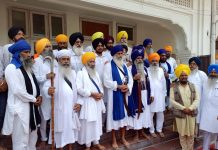As we see the unfolding of the periodic, and farcical, spectacle of the Indian Lok Sabha Elections to be held in May this year, one is confronted with the question, which political party should Sikhs support? Though, due to a combination of carrot (alcohol, drugs and money), and stick (threats to deprive villages of resources), along with media propaganda, one cannot but think that Sikh voters in Punjab will, in large numbers, support the established parties –Akali/ Bharatiya Janata Party (BJP) /Congress. One does wonder however, whether we could be on the verge of something new. I am of course thinking about the emergence of a third force in the shape of the Aam Adamai Party (AAP) which has attracted high profile Sikh human rights activists such as the lawyer, H.S Phoolka, and Delhi based Journalist Jarnail Singh.
![Nishan Sahib Photo © [S Khalsa]](http://www.sikh24.com/wp-content/uploads/Nishann-Sikh24-DSC_0015-303x355.jpg)
![Nishan Sahib Photo © [S Khalsa]](http://www.sikh24.com/wp-content/uploads/Nishann-Sikh24-DSC_0015-303x355.jpg)
![Nishan Sahib Photo © [S Khalsa]](http://www.sikh24.com/wp-content/uploads/Nishann-Sikh24-DSC_0015-303x355.jpg)
Since his high profile national campaign against corruption, and other forms of criminality amongst elected politicians, the leader of the AAP, and former Chief Minister of Delhi, Arvind Kejarival has appeared like a knight in shining armor, offering Sikh, and non-Sikh, voters a possibility that their cries for social, and political, justice may finally be heard. Some cynics argue that the AAP is simply a clever attempt by the Congress to re-brand itself, and that behind the scenes deals are being made to divvy out the various seats with a view to forming a coalition government. However, others interpret the emergence of the AAP as a kin to the development in the Middle East over the past three years as an Indian version of the Arab Springs.
Only time will tell, but there is no doubt since the melt down of the various Communist, and Naxalite parties in Punjab on the one hand, and the destruction of the Sikh separatist movement during the 1980’s, and 1990’s, there is certainly a gaping gap for the formation of a radical revolutionary alternative for the people of Punjab, and indeed all of India. Moreover, of all the world’s major countries, India has the youngest population, and the oldest leaders. In short, we are seeing the emergence of a huge generation gap which is made even bigger due to the influence of social media. Though many young Punjabis have succumbed either to drugs, or the false hopes offered by agents through legal and illegal immigration, what certainly unites the youth of India is a combination of increased expectations, poor employment prospects, and rejection of the tradition authority of both spiritual, and secular, institutions.
A key factor in this new found realization that the world isn’t simply a given, is the power of social media. Today, through face book and twitter, the youth of India and those across the world are busy constructing an alternative narrative to the ‘official’ versions. And so what we have now is a potent mix. A cursory scan of the historical references will reveal that generations with an high youth ratio create political movements that shake up their systems,which leave a profound impact on history. One can see in the most recent revolutions in the Arab world significant evidence of a strong correlation between the ratio of the population under 25, and the urge to overthrow unresponsive governments.
Whether India will follow the same path may become apparent in the very near future, but the signs a certainly there, perhaps most spectacularly displayed in the Dec 2012 incidentof the gang rape and murder of a student in the capital city Delhi, which led to violent protests by students, feminist, and human rights activists across India, and resulted in new laws against rape.
So, where do the Sikhs and Sikh ideology fit into the current zeitgeist? Should we follow the advise of the current crop of Jathedars and Pardans, of this committee, and that, waiting to see if they effect change from within through the ‘democratic’ process? Or should we seek to ferment an Arab spring, and pursue a revolutionary path? Indeed, what would the Gurus council if they were present today? One can only ponder what the answer might be, but I recently engaged in a with a prominent Sikh media personality about the efficacy of radical and revolutionary politics, which I believe is the only way forward for Sikhs, and all Indians.
He suggested that slow reform was the best way to achieve our goals, and that we should be acting to strengthen the democratic structures in India. My response was that, given the endemic corruption in India, and the systematic genocide of Sikhs under the so-called ‘democratic’ and ‘free’ India, perhaps this option is no longer credible. This exchange also led me to reflect on the example that was set by our Gurus. Were they radical revolutionaries, or reformists?
What we do know without any doubt, is that the Gurus, despite the odds, were not willing to allow injustice to happen. Each and every one in their own way confronted power and oppression. Guru Nanak who not only declared emperor Babur to be a tyrant for which he was imprisoned, also condemned many of the prevailing Brahminical practices, and ideologies of his time. Guru Arjan, collated in a single volume, the AdiGranth, the writings of Muslim, Hindu, and Sikhs saints who preached a universal message of honest living (anti-corruption), sharing one’s wealth (material equality,) and leading a spiritually contemplative life (anti-egotism). Guru Arjun Dev Ji was martyred because of his stance on freedom of speech. Guru Hargobind Ji fought wars against the Mughals, who, following the death of Akbar, were were seeking to enslave the Indian masses. Guru TegBahadar Ji confronted Emperor Aurangzeb for his policy of intolerance towards other faiths, and was beheaded in the process. And of course we have in the figure of Guru Gobind Singh Ji a true revolutionary who not only sought to destroy the prevailing, and oppressive, caste system by declaring the human race as one, he also fought battles against tyrants and rulers of the time, resulting in the establishment of a revolutionary Khalsa raj under the leadership of Banda Singh Bahadar.
Even a cursory examination like this into the actions and beliefs of the Gurus clearly affirms that Sikhi does not tolerate oppression and injustice, and in this sense there can be no doubt is a revolutionary force. Sikhi was never interred to be a religion, but is more akin to a social, and political movement, which like a river cannot exist unless it is engaged in continuous revolution. When most people invoke the word ‘revolution’ it conjurers up images of the former Soviet Union, or North Korea, and China. What we have to do, is to banish from the mind those failed, reprehensible, Communist revolutions, which deviated way from the ideals of revolutionary Marxism, and became an excuse for the denial of human rights, and equality. Sikhi is a unique holistic way of life, which poses a threat to both atheists, and religious fanatics, to dictators, and corrupt politicians.
The ‘miri–piri’ (spiritual -secular) concept of Sikhi is just about the most revolutionary idea one can imagine. Our Gurus required of us nothing less than a commitment to create heaven on earth, which they referred to as ‘haleimi raj’ (a place where all live in peace and co-operation), or what Bhagat Ravidaas jiterms ‘Begumpura‘ (place of peace, bliss, and equality). And so, whether one puts faith in the ballot box, and peruses an electoral strategy, or one takes to the streets, is not the question. The question is what kind of world society do we want inhabit, what legacy do we wish to leave for our children, and their children. Though India is certainly a world leader, sadly today’s political class across the globe has succumbed to greed, criminality, and corruption. To cure this, there is no doubt that a revolution in thinking, and acting, is required. For Sikhs, this will mean coming out of the gurdwaras, and supporting good honest people, whatever their political party. It means being the change we want to see, by not colluding with corruption, and above all it means reclaiming, and implementing, the true mission of our Gurus’ ideals of justice and equality. Doing so will be to receive the Gurus’ blessings, and real miracles will occur; the masses will join together, and ordinary people will begin to realize that there is a better way to organize our society, to live with our fellow human beings, and to look after our planet which sustains all life.
Please tick gurnam singh column
As we see the unfolding of the periodic and farcical spectacle of the Indian Lok Sabha Elections to be held in May this year, one is confronted with the question, which political party should Sikhs support? Though, due to a combination of carrot (Alcohol, drugs and money) and stick (Threats to deprive villages of resources) and media propaganda, one cannot but think Sikh voters in Punjabwill in large numbers support the established parties –Akali/BJP/Congress – one does wonder whether we could be on the verge of something new. I am of course thinking about the emergence of a third force in the shape of the Aam Adamai Party AAP which has attracted high profile Sikh human rights activists such as the lawyer, H.S Phoolka and Delhi based Journalist JarnailSingh.
Since his high profile national campaign against corruption and other forms of criminality amongst elected politicians, the leader of the AAP and former Chief Minister of Delhi Arvind Kejarival has appeared like a knight in shining armour offering Sikh and non-Sikh voters a possibility that their cries for social and political justice may finally be heard. Some cynics argue that the AAP is simply a clever attempt by the Congress to rebrand itself and behind the scenes deals are being made to divvy out the various seats with a view to forming a coalition government. However, others interpret the emergence of the AAP as a kin to the development in the Middle East over the past 3 years as an Indian version of the Arab Springs.
Only time will tell, but there is no doubt since the melt done of the various Communist and Naxalite parties inPunjab on the one hand and the destruction of the Sikh separatist movement during the 1980’s and 1990’s there is certainly a gaping gap for a radical revolutionary alternative for the people of Punjab and indeed, India more widely. Moreover, of all the world’s major countries, India has the youngest population, and the oldest leaders. In short, we are seeing the emergence of a huge generation gap which is made even bigger due to the influence of social media. Though many youngPunjabis have succumbed either to drugs or the false hopes offered by agents through legal and illegal emigration, what certainly unites the youth of India is a combination of increased expectations, poor employment prospects, and perhaps most significantly a rejection of tradition authority of both religious or secular institutions.
A key factor in this new found realisation that the world isn’t simply a given is the power of social media. Today, through face book and twitter, the youth of India and across the world are busy constructing an alternative narrative to the ‘official’ versions. And so what we have now is a potent mix. A cursory scan of the historical references will reveal that generations with an high youth ratio create political movements that shake up their systems and leave a profound impact on history. One can see in the most recent revolutions in the Arab world significant evidence of a strong correlation between theratio of the population under 25 and the urge to overthrow unresponsive governments.
Whether India will follow the same path may become apparent in the very near future, but the signs a certainly there, perhaps most spectacularly displayed in the incident in Dec 2012 of a gang rape and murder of a student in the capital city Delhi which led to violent protests by students, feminist and human rights activistsacross India and new laws against rape.
So, where do the Siks and Sikh ideology fit into the current zeitgeist? Should we follow the advise of the current crop of Jathedars and Pardans of this committee and that, see to effect change from within through the ‘democratic’ process? Or should we seek to ferment an Arab spring and pursue a revolutionary path? Indeed, what would the Gurus council if they were present today? One can only ponder what the answer might be, but I recently engaged in a with a prominant Sikh media personality about the efficacy of radical and revolutionary politics, which I believe is the only way forward for Sikhs and Indians more generally.
He was suggesting that slow reform was the best way to achieve our goals and that we should be acting to strengthen the democratic structures in India. My response was that, given the endemic corruption in India and the systematic genocide of Sikhs under the so-called ‘democratic’ and ‘free’ India, perhaps this option is no longer credible. This exchange also led me to reflect on the example that was set by our Gurus. Were they radical revolutionaries or reformists?
What we do know without any doubt, the Gurus, despite the odds, were not willing to allow injustice to happen. Each and every one in their own way confronted power and oppression. Guru Nanak who not only declared emperor Babur to be a tyrant for which he was imprisoned, also condemned many of the prevailingBrahminical practices and ideologies of his time. GuruArjan, collated in a single granth, the Aad Granth Ji, the writings of Muslim, Hindu and Sikhs saints whopreached a universal message of honest living (anti-corruption), sharing one’s wealth (material equality) and spiritual contemplative live (anti-egotism). Guru AjranDev Ji was martyred because of his stance on freedom of speech. Guru Hargobind Ji fought wars against the Moguls, who, following the death of Akbar, were wereseeking to enslave the Indian masses. Guru Teg BhadurJi confronted Emperor Aurangzeb for his policy of intolerance towards other faiths and was beheaded in the process. And of course we have in the figure of GuruGobind Singh ji a true revolutionary who not only sought to destroy the prevailing and oppressive caste system by declaring the human race as one, he also fought battles against tyrants and rulers of the time, resulting in the establishment of a revolutionary Khalsa raj under the leadership of Banda Singh Bahadur.
Even a cursory examination like this into the actions and beliefs of the Gurus clearly affirms that Sikhi does not tolerate oppression and injustice and in this sense there can be no doubt is a revolutionary force. Sikhi was neverintered to be a religion, but is more akin to a social and political movement, which like a river cannot exist unless it is engaged in continuous revolution. When most people invoke the word ‘revolution’ is conjours up images of the former Soviet Union, or North Korea and China. What we have to do is get out of your mind the failed and reprehensible Communist revolutions, which deviated way from the ideals of revolutionary Marxism and became an excuse for the denial of human rights and equality. Sikhi is a unique holistic way of life, whichposes a threat to both atheists and religious fanatics, to dictators and corrupt politicians.
The ‘miri piri’ concept in Sikh is just about the most revolutionary idea one can think about. Our gurus required of us nothing less than a commitment to create heaven on earth, which they referred to as ‘haleimi raj’ (A place where all live in peace and co-operation) or whatBhagat Ravidaas ji termes ‘Begumpura‘ (Place of peace, bliss and equality). And so, whether one puts faith in the ballot box and peruses an electoral strategy or one takes to the streets it not the question. The question is what kind of society and world do we want inhabit, what legacy do we wish to leave for our children and their children. Though India is certainly a world leader, sadly today’s political class across the globe has succumbed to greed, criminality and corruption. To cure this, there is no doubt that a revolution in thinking and acting is required. For Sikhs, this will mean coming out of theGurdwaras and supporting good honest people, whatever their political party, it means being the change we want to see by not colluding with corruption, and above all it means reclaiming and implementing the true mission of our Gurus of justice and equality. And by doing so will be receive the gurus blessings and real miracles will occur; the masses will join you and ordinary people will begin to realise that there is a better way to organise our society, to live with out fellow human beings and to look after the planet that sustains all live.
Dr Gurnam Singh, Sikh Channel Presenter and Human Rights Activist





This
was an interesting article and a refreshing read. Leading a revolution in the ‘world society’ today
must start somewhere, otherwise you will not have a leg to stand on. This does not mean nepotism, it means strengthening,
reforming, and re-building those indigenous institutions founded, many by the
Gurus themselves, in the pre-colonial period that have since been destroyed,
diluted, or simply taken away. Examples
include a civil service that is meritocratic and a strong judiciary that is biased
towards promoting universal humanitarian principles.